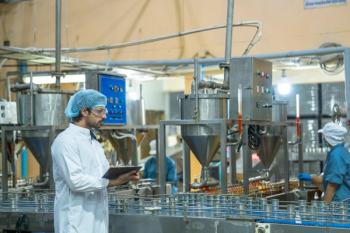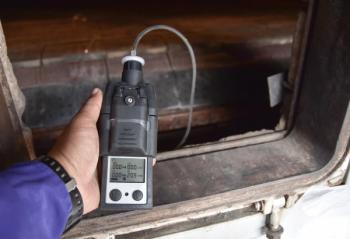
Best of the Week: SERS in Complex Environments, Off-Gas Monitoring
Key Takeaways
- Advancements in SERS focus on overcoming adsorption challenges and developing robust substrates for broader analytical use.
- Raman spectroscopy enhances nuclear materials processing by providing real-time chemical feedback for process optimization.
Top articles published this week include several video interviews from our coverage of the SciX Conference and an inside look at classical correction methods.
This week, Spectroscopy published a variety of articles highlighting recent studies in several application areas. Key techniques highlighted in these articles include surface-enhanced Raman spectroscopy (SERS), Raman spectroscopy, and machine learning. Happy reading!
In this interview from the 2025 SciX Conference, Steven Bell of Queen’s University Belfast discusses recent advancements in surface-enhanced Raman spectroscopy (SERS) and the challenges limiting its broader adoption. SERS enhances Raman signals using nanostructured metal surfaces, allowing highly sensitive molecular detection for applications in medicine, forensics, and environmental monitoring (1). Bell outlines key obstacles, including adsorption challenges and the need for more robust, reproducible substrates, while highlighting his group’s efforts to develop new nano- and microstructured materials (1). He emphasized that overcoming these technical barriers is essential for SERS to move beyond specialized laboratories into mainstream analytical use.
At the 2025 SciX Conference in Covington, Kentucky, Rob Lascola, Senior Fellow Scientist at Savannah River National Laboratory, discussed how Raman spectroscopy is advancing nuclear materials processing. His presentation highlighted Raman’s role in monitoring critical stages such as fuel dissolution and solvent extraction, providing real-time chemical feedback to optimize efficiency and safety (2). Lascola’s group develops systems for off-gas monitoring, acidity measurement, and studying lanthanide dissolution as a model for actinide behavior (2). In the interview, he explained how Raman complements other spectroscopic methods to enhance process control and understanding within the broader Department of Energy’s nuclear fuel cycle research efforts.
This tutorial from Spectroscopy executive editor Jerome Workman Jr. examines how baseline drift, particle size variation, and multiplicative scatter distort spectroscopic data, obscuring chemical information and complicating calibration transfer. It reviews classical correction methods, including multiplicative scatter correction (MSC), standard normal variate (SNV), and extended MSC (EMSC), alongside modern techniques such as wavelet-based correction, asymmetric least squares (AsLS) baseline fitting, and emerging machine learning (ML)-based scatter modeling (3). Mathematical formulations are presented in matrix notation with applications across near-infrared (NIR), infrared (IR), and Raman spectroscopy (3). The article emphasizes balancing correction strength with chemical signal preservation, highlighting ongoing challenges and future directions in hybrid physical-statistical modeling, transfer learning, and adaptive real-time correction for robust, interpretable spectroscopic analysis (3).
James D. Winefordner (1931–2025) was a figure in analytical chemistry whose research in spectrochemical analysis, instrumentation, and detection limits shaped modern trace analysis. Over a six-decade career at the University of Florida, he published more than 900 papers, mentored 168 Ph.D. students and over 100 postdoctoral researchers, and raised over $25 million in research funding (4). His influential studies on laser-induced plasmas, aerosol sampling, and analytical sensitivity earned him global recognition, including major American Chemical Society (ACS) and Society of Applied Spectroscopy (SAS) awards. Remembered as a brilliant scientist, inspiring mentor, and compassionate colleague, Winefordner’s legacy continues to guide generations in analytical science and education (4).
In Macromolecular Rapid Communications, researchers Bahar Dadfar, Berna Alemdag, and Gözde Kabay trace the evolution of polymer chemistry from early trial-and-error methods to autonomous, AI-driven discovery. They outline three eras, including the alchemist’s, scientist’s, and robot’s, which resulted in self-driving laboratories (SDLs) that use robotics, spectroscopy, and machine learning to accelerate polymer synthesis (5). Although SDLs automate experimentation, the authors emphasize that true progress depends on “symbiotic autonomy,” where human intuition, ethics, and creativity guide AI insights (5). Tools like digital twins, explainable AI, and spectroscopic feedback loops will enable smarter, more transparent, and ethically grounded materials discovery in the future.
References
- Wetzel, W. How to Improve SERS for Wider Adoption in Complex Environments. Spectroscopy. Available at:
https://www.spectroscopyonline.com/view/how-to-improve-sers-for-wider-adoption-in-complex-environments (accessed 2025-10-15). - Wetzel, W. Off-Gas Monitoring for Fuel Dissolution. Spectroscopy. Available at:
https://www.spectroscopyonline.com/view/off-gas-monitoring-for-fuel-dissolution (accessed 2025-10-15). - Workman, Jr., J. Baseline and Scatter: Correcting the Spectral Chameleons. Spectroscopy. Available at:
https://www.spectroscopyonline.com/view/baseline-and-scatter-correcting-the-spectral-chameleons (accessed 2025-10-15). - Workman, Jr., J. In Memory of James D. Winefordner (1931–2025). Spectroscopy. Available at:
https://www.spectroscopyonline.com/view/in-memory-of-james-d-winefordner-1931-2025- (accessed 2025-10-15). - Workman, Jr., J. Humans and Machines Unite Using Symbiotic AI to Transform Polymer Chemistry and Spectroscopy. Spectroscopy. Available at:
https://www.spectroscopyonline.com/view/humans-and-machines-unite-using-symbiotic-ai-to-transform-polymer-chemistry-and-spectroscopy (accessed 2025-10-15).
Newsletter
Get essential updates on the latest spectroscopy technologies, regulatory standards, and best practices—subscribe today to Spectroscopy.





